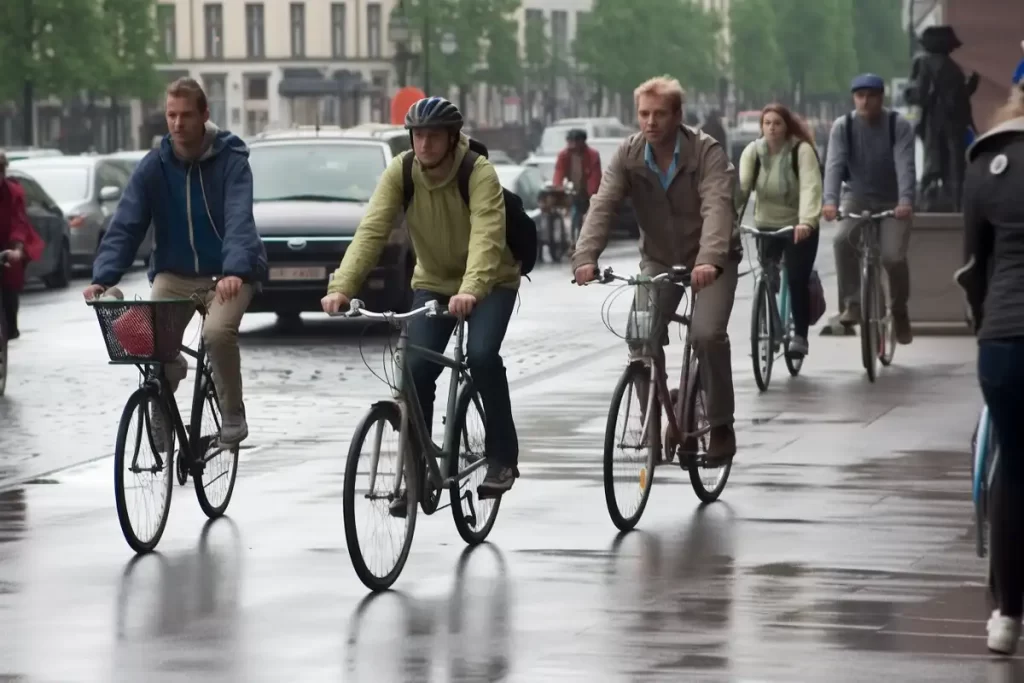As global concerns about climate change and energy consumption continue to rise, public transportation plays a pivotal role in promoting sustainability. Public transportation systems, including buses, trains, trams, and cycling, help reduce our reliance on fossil fuels, decrease traffic congestion, and lower greenhouse gas emissions. This article aims to quantify the energy savings associated with public transportation and discuss the factors affecting these savings.
The Role of Public Transportation in Reducing Energy Consumption
Public transportation significantly impacts energy consumption by providing an alternative to private vehicles. With fewer cars on the road, traffic congestion is reduced, leading to decreased fuel consumption and emissions. Furthermore, public transportation systems are often more energy-efficient than individual vehicles, further contributing to energy savings. For instance, electric buses and trains produce fewer emissions and consume less energy than their conventional counterparts.
| Opportunity | Description |
|---|---|
| Renewable Energy Integration | Use of renewable energy sources, such as solar and wind, to power public transportation vehicles and systems |
| Advanced Vehicle Technologies | Development and adoption of hydrogen fuel cells, electric batteries, and other energy-efficient technologies |
| Infrastructure Investment | Investment in sustainable transportation infrastructure, such as cycling lanes and electric vehicle charging stations |
| Policy Changes | Implementation of policies that promote sustainable transportation, such as tax incentives and subsidies |
| Public Education and Awareness | Increasing public awareness of the environmental benefits of public transportation and sustainable travel |
Factors Affecting Energy Savings in Public Transportation
Several factors determine the energy efficiency of public transportation systems, such as ridership levels, vehicle types, and operational efficiency. High ridership levels lead to higher energy savings, as more people using public transportation means fewer private vehicles on the road [1]. Additionally, the type of vehicle used (e.g., electric vs. fossil fuel-powered) directly affects energy efficiency. Lastly, operational efficiency, such as route planning and vehicle maintenance, plays a crucial role in reducing energy consumption.
| City | Country | Notable Features of Public Transportation System |
|---|---|---|
| Copenhagen | Denmark | Extensive network of buses, trains, and bicycles; promotion of renewable energy sources [2] |
| Tokyo | Japan | Efficient and extensive train system; high ridership levels [3] |
| Amsterdam | Netherlands | Integrated public transportation system; extensive cycling infrastructure [4] |
| Stockholm | Sweden | Comprehensive public transportation system; investment in renewable energy for transportation |
| Portland | United States | Well-developed light rail and bus system; focus on sustainable transportation initiatives [5] |
Different modes of public transportation (buses, trains, trams, etc.) also have varying energy efficiencies. For example, electric trains are more energy-efficient than diesel trains, while electric buses produce fewer emissions than diesel buses.
Energy Savings by Mode of Public Transportation
1. Buses
Buses, especially electric ones, offer substantial energy savings compared to private vehicles. A single electric bus can replace multiple cars on the road, reducing traffic congestion and emissions. Moreover, electric buses are more energy-efficient, consuming less energy per passenger-mile than conventional diesel buses [6].
2. Trains
Trains provide considerable energy savings, especially when powered by electricity or other renewable sources. High-speed and electric trains offer even greater energy efficiency, reducing the need for short-haul flights and long car journeys [7]. Additionally, trains have a lower environmental impact than cars, producing fewer emissions and consuming less energy per passenger-mile.

3. Trams and Light Rail
Trams and light rail systems are highly energy-efficient and well-suited for urban environments [8]. They have lower energy consumption than buses and cars, reducing traffic congestion and emissions. Moreover, trams and light rail systems can run on renewable energy sources, further minimizing their environmental impact.
4. Cycling and Walking
Active transportation, such as cycling and walking, plays a crucial role in saving energy and promoting sustainability. These modes of transportation consume no fuel, produce zero emissions, and offer numerous health benefits for individuals. Encouraging more people to walk or cycle for short distances can significantly reduce the energy consumption associated with transportation [9]. The following table shows the energy consumed per passenger-mile in the United States:
| Mode of Transportation | Energy Consumption (BTU per passenger-mile) |
|---|---|
| Private Car (Gasoline) | 3,500 [10] |
| Private Car (hybrid) | 1,300 [10] |
| Bus | 4,600 [11] |
| Bus (Electric) | 2,000 |
| Train | 2,400 [11] |
| Train (Electric) | 1,500 |
| Tram/Light Rail | 1,800 [11] |
| Cycling | 0 |
| Walking | 0 |
*Note: The energy consumption values provided are approximate and can vary depending on vehicle type, operation, and local conditions.
Case Studies of Energy Savings in Public Transportation Systems
Several cities and countries have successfully implemented public transportation systems that have resulted in significant energy savings. For example, Copenhagen, Denmark, boasts an extensive and efficient public transportation network, including buses, trains, and bicycles, which has reduced traffic congestion and emissions [12]. Similarly, Tokyo, Japan, is well-known for its extensive and energy-efficient train system, helping the city reduce its energy consumption and environmental impact.
These successful systems are often the result of specific measures and policies, such as investment in infrastructure, promotion of sustainable transportation modes, and integration of renewable energy sources into public transportation networks.
Challenges and Opportunities for Increasing Energy Savings
Implementing energy-efficient public transportation systems comes with its challenges, such as funding, public acceptance, and balancing the needs of diverse populations. However, there are numerous opportunities for further energy savings through advancements in technology, policy changes, and shifting public attitudes.
For instance, continued investment in renewable energy sources, such as wind and solar, can help power public transportation systems more sustainably. Additionally, the development of new technologies, such as hydrogen fuel cells and electric vehicle batteries, can improve the energy efficiency of public transportation vehicles.
Energy Savings and CO2 Reduction by Buses
Buses are an essential part of public transportation systems worldwide. Compared to single-occupancy vehicles, buses can transport a higher number of passengers, which leads to a reduction in overall energy consumption and CO2 emissions.
A passenger car carrying one person emits 89 pounds of CO2 per 100 passenger miles, while a full bus emits only 14 pounds [13]. Buses powered by alternative fuels, such as natural gas or electricity, can further reduce CO2 emissions.
Public Transport’s Role in Combating Global Warming
Public transportation helps mitigate global warming by reducing the number of vehicles on the road. This reduces congestion, leading to lower fuel consumption and fewer emissions. Additionally, many public transport systems are increasingly adopting eco-friendly technologies, such as electric buses or trains, which produce little or no emissions.

Efficiency of Public Transportation Systems
Public transportation systems are often more energy-efficient than private vehicles, especially when operating at full capacity. Trains and buses can transport a large number of passengers with relatively low energy consumption per person, resulting in a smaller carbon footprint compared to individual car use.
Carbon Footprint of Buses
The carbon footprint of a bus depends on various factors, including the type of fuel it uses, its size, and passenger capacity. Generally, diesel buses emit around 0.089 grams of CO2 per passenger kilometer [14]. Electric buses, on the other hand, have a significantly lower carbon footprint, especially when powered by renewable energy sources.
Carbon Savings Through Public Transport Use
By choosing public transportation over private vehicles, individuals can significantly reduce their carbon footprint. For example, using public transport for a 10-mile round trip can save around 20 pounds of CO2 emissions [15]. Over a year, this translates into substantial carbon savings, contributing to the fight against climate change.
Comparing Buses and Trains: Environmental Impact
Both buses and trains are more environmentally friendly than single-occupancy vehicles. Trains tend to be more energy-efficient than buses, especially electric trains powered by renewable energy sources. However, the environmental impact of each mode depends on factors such as fuel type, occupancy rate, and distance traveled.
Eco-Friendly Transport Options
Eco-friendly transport options include electric or hybrid vehicles, bikes, walking, and carpooling. These modes of transport produce fewer emissions and consume less energy compared to conventional vehicles. Adopting eco-friendly transportation habits can significantly reduce an individual’s carbon footprint and contribute to sustainable living.
The Most Sustainable Modes of Transport
Walking and cycling are the most sustainable modes of transport, as they produce no emissions and require minimal resources. Public transportation, such as buses and trains, is also more sustainable than private vehicles, particularly when powered by renewable energy sources.
The Most Polluting Forms of Transport
Air travel is considered the most polluting form of transport, with significant greenhouse gas emissions per passenger mile. Single-occupancy vehicles, especially those with low fuel efficiency, also have a high environmental impact.
Best Public Transport Options for the Environment
Electric trains and buses are the most environmentally friendly public transport options. They produce little or no emissions, and their energy consumption is generally lower than that of diesel or natural gas-powered vehicles.
Main Advantages of Public Transport
The primary advantage of public transport is its ability to reduce energy consumption and greenhouse gas emissions by carrying multiple passengers at once. Public transportation also helps alleviate traffic congestion, reduces demand for parking spaces, and can promote more sustainable urban development
Conclusion
Public transportation plays a vital role in promoting sustainability by reducing energy consumption and greenhouse gas emissions. Buses, trains, and eco-friendly transport options offer more energy-efficient alternatives to private vehicles. By choosing public transportation, individuals can reduce their carbon footprint, contribute to the fight against climate change, and promote sustainable living.
Incorporating sustainable transport options, such as cycling and walking, into daily routines can further reduce one’s environmental impact. Additionally, staying informed about sustainable development goals and advocating for better public transportation policies can contribute to a more sustainable future.
By prioritizing sustainable transportation options and supporting investments in greener public transit systems, we can collectively work towards a cleaner, healthier, and more environmentally responsible world.

